Student Projects
These student projects are examples of how the teachers involved in the course applied what they learned to their classroom curricula. These are not presented in the form of lesson plans with objectives, materials, and procedural steps. They are intended rather to furnish ideas that will enrich new or existing curriculur units or lesson plans.
1. So You Want To Buy a Painting?
School: Lincoln Park High School
Class: 12th grade Chemistry
Teacher: Patricia A. Riley
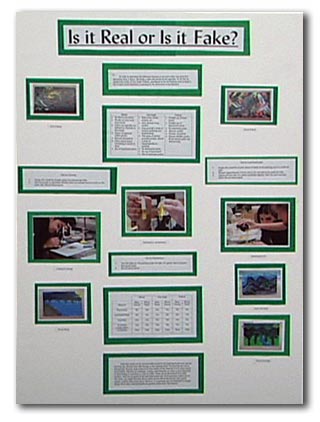 Ms. Riley’s 12th-grade chemistry students asssumed the role of art buyers interested in purchasing paintings by Vincent van Gogh, Claude Monet, and Jackson Pollock. To prepare for their project, the students took a self-guided tour of The Art Institute of Chicago to familiarize themselves with the three painters’ subject matter and style of painting. In their classroom, the students learned how ultraviolet fluorescence, spectroscopy, infrared spectroscopy, reflectography, X-ray diffraction, microscopy, pigment analysis and gas chromatography may be used to authenticate works of art. Ms. Riley’s 12th-grade chemistry students asssumed the role of art buyers interested in purchasing paintings by Vincent van Gogh, Claude Monet, and Jackson Pollock. To prepare for their project, the students took a self-guided tour of The Art Institute of Chicago to familiarize themselves with the three painters’ subject matter and style of painting. In their classroom, the students learned how ultraviolet fluorescence, spectroscopy, infrared spectroscopy, reflectography, X-ray diffraction, microscopy, pigment analysis and gas chromatography may be used to authenticate works of art.
For their project, each student created three paintings, one in the style of each of the three artists studied. They were required to make at least one painting “authentic” and at least one painting a “forgery”. Student groups then switched paintings with one another and used a series of tests to determine which of the paintings were authentic based on predetermined criteria. These tests included ultraviolet inspection, microscopic paint chip analysis, and chemical tests that checked for the presence of lead chromate, paint layering, or fluorescent paint. After completing the project, a student remarked that “when I come [to the Art Institute], usually it’s to appreciate the beauty of art. This time it was a lot more focused on content . . . and the technique of the artists. It’s nice because I look and can appreciate what the art is about.” |
Suggested Curriculum Connections
1. spectroscopy
2. chromatography
3. microscopy |
| |
2. Color Discovery
School: Lindblom College Preparatory High School
Class: Biology and Environmental Science
Teacher: Karen Williams
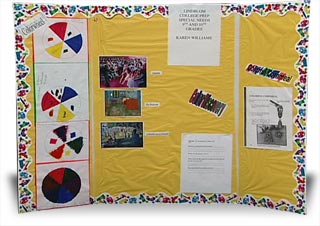 Ms. Williams’ goal for this project was to allow her students to explore color and illustrate how color is used by artists to affect the emotions of their viewers. Students learned what makes color appear and the difference between a primary and secondary colors. Students also created their own color wheels, using cornmeal and food coloring as the media to mix their own colors. While mixing, students recorded the number of drops of food coloring it took to achieve a particular color, as well as the different color combinations of food coloring used. In preparation for their self-guided tour at The Art Institute of Chicago, students viewed slides of works of art in the museum and discussed the colors found within them, the possible reasons the artists chose their particular colors, and how the paintings’ colors affect emotions. Ms. Williams’ goal for this project was to allow her students to explore color and illustrate how color is used by artists to affect the emotions of their viewers. Students learned what makes color appear and the difference between a primary and secondary colors. Students also created their own color wheels, using cornmeal and food coloring as the media to mix their own colors. While mixing, students recorded the number of drops of food coloring it took to achieve a particular color, as well as the different color combinations of food coloring used. In preparation for their self-guided tour at The Art Institute of Chicago, students viewed slides of works of art in the museum and discussed the colors found within them, the possible reasons the artists chose their particular colors, and how the paintings’ colors affect emotions. |
Suggested Curriculum Connections
1. properties of matter
2. observation and inference
3. perception |
| |
3. |
• The Connection Between Pigment Colors and Light Colors
• Can Chromatography Separate a Pigment Mixture?
• Painting Like an Impressionist
• Flame Test and Spectroscopy |
School: Flower Career Academy
Class: Chemistry
Teacher: Mae Eubanks-Love
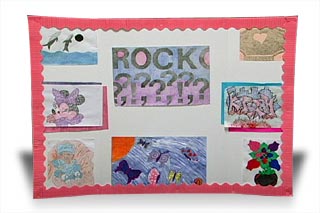 The students in Mae Eubanks-Love’s chemistry class executed several projects to become familiar with different painting styles and the process of authenticating paintings. In the first portion of their project, students focused on understanding the relationship between a pigment’s hue and its molecules’ wave absorption and reflection properties. In the second, the class used an ion exchange matrix to separate pigments by their characteristic charges. During the third portion of the project, students learned how to use a flame test to identify the metals and compounds in paint based on their characteristic flame colors. In the fourth portion, students took a self-guided tour of The Art Institute of Chicago’s Impressionist galleries. This tour prepared them for the final part of the project, in which students learned some basic Impressionist painting techniques. They then wrote research papers on Impressionist artists and created paintings in the Impressionist style. One student wrote, “it was very creative to combine art and science. We noticed art such as pointillism, [in] which like a million and one dots combined to make one picture.” The students in Mae Eubanks-Love’s chemistry class executed several projects to become familiar with different painting styles and the process of authenticating paintings. In the first portion of their project, students focused on understanding the relationship between a pigment’s hue and its molecules’ wave absorption and reflection properties. In the second, the class used an ion exchange matrix to separate pigments by their characteristic charges. During the third portion of the project, students learned how to use a flame test to identify the metals and compounds in paint based on their characteristic flame colors. In the fourth portion, students took a self-guided tour of The Art Institute of Chicago’s Impressionist galleries. This tour prepared them for the final part of the project, in which students learned some basic Impressionist painting techniques. They then wrote research papers on Impressionist artists and created paintings in the Impressionist style. One student wrote, “it was very creative to combine art and science. We noticed art such as pointillism, [in] which like a million and one dots combined to make one picture.” |
Suggested Curriculum Connections
1. chromatography
2. light and wavelength
3. acids and bases |
| |
4. Art Through the Eye of a Chemist
School: Washington High School
Class: 10th and llth grade International Baccalaureate and Science Club students
Teacher: Rita Koziarski
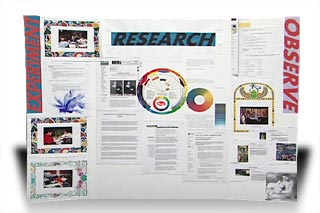 In this project, Ms. Koziarski’s students learned how chemistry skills can be applied to their understanding and appreciation of art. During a field trip to The Art Institute of Chicago, students chose paintings; noted each work’s condition, medium, and colors; and recorded their personal reactions to the paintings. The students also studied the compositions of the painters’ canvases. One student commented that “[we] talked about complementary colors and how their use makes paintings more vivid, like the Georges Seurat painting. He used the dots and with the dots he used complementary colors and that way it made the picture more attractive.” In this project, Ms. Koziarski’s students learned how chemistry skills can be applied to their understanding and appreciation of art. During a field trip to The Art Institute of Chicago, students chose paintings; noted each work’s condition, medium, and colors; and recorded their personal reactions to the paintings. The students also studied the compositions of the painters’ canvases. One student commented that “[we] talked about complementary colors and how their use makes paintings more vivid, like the Georges Seurat painting. He used the dots and with the dots he used complementary colors and that way it made the picture more attractive.”
Back in the classroom, students made tempera paint using an egg yolk and water emulsion and various pigments. The paint was then centrifuged and its layers—pigment, binder, and solvent—separated. The pigments were further separated out using paper chromatography. Students then conducted additional research on a particular color of their choice and researched its pigments, production, chemical composition, and emotional effect on people. |
Suggested Curriculum Connections
1. chromatography
2. observation and inference
3. chemical and physical reactions |
| |
5. |
• Sculptures from Various Cultures and Centuries
• Exploring Chicago’s Public Sculpture |
School: George Washington High School
Class: Earth Science
Teacher: Stella Muir
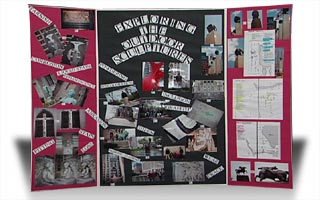 Stella Muir’s Earth Science class project began with a focused study of various stone sculptures at The Art Institute of Chicago. Students explored the different types of stone used by sculptors and their properties. In the classroom, they then simulated the conservation of outdoor sculptures by applying different protective coatings to rock samples. The class also took a field trip into the city and studied several of Chicago’s outdoor sculptures. For each, students identified the material composition, described the physical condition, and photographed the sculptures in order to record the current condition. Students also discussed the adverse effects of acid rain on outdoor sculpture and concrete buildings. Stella Muir’s Earth Science class project began with a focused study of various stone sculptures at The Art Institute of Chicago. Students explored the different types of stone used by sculptors and their properties. In the classroom, they then simulated the conservation of outdoor sculptures by applying different protective coatings to rock samples. The class also took a field trip into the city and studied several of Chicago’s outdoor sculptures. For each, students identified the material composition, described the physical condition, and photographed the sculptures in order to record the current condition. Students also discussed the adverse effects of acid rain on outdoor sculpture and concrete buildings. |
Suggested Curriculum Connections
1. properties of matter
2. observation and inference
3. acid rain |
| |
6. Let’s Look at the Color Blue
School: William Rainey Harper High School
Class: Chemistry
Teacher: Marian Murphy
Marian Murphy’s chemistry students focused their study on the color blue. They learned how both natural and artificial pigments are produced; used spectroscopy as a tool to analyze paint composition; discussed light absorption, emission and dispersion; and studied the different properties of the chemical substances that create the color blue. Some of the substances investigated were: lapis lazuli, copper, cobalt, iron, and sulfur. One student observed that “it sometimes takes three colors to make one color.” During a culminating field trip to The Art Institute of Chicago, students identified and studied paintings that contained the color blue.
Suggested Curriculum Connections
1. spectroscopy
2. properties of light
3. chemical reactions
7. Chemistry in Art
School: Benito Juarez Community Academy
Class: Chemistry
Teacher: Sheri Delp
Students in Sheri Delp’s chemistry class used their knowledge to examine works of art, color relativity, and the difference between chemical and physical color changes. On their self-guided tour of The Art Institute of Chicago, students studied paint texture and color. They looked for signs of chemical or physical changes in the paintings. They also identified different types of photographs based on the chemicals used to develop them. One student commented that doing this project “expanded our knowledge of chemistry and of physical and chemical changes. We found out that chemistry does have something to do with art!” For their final project, student groups gave presentations on the connections between art and chemistry.
Suggested Curriculum Connections
1. chemical reactions
2. physical reactions
3. perception
8. The Artist’s Palette
School: Hubbard High School
Class: Chemistry
Teacher: Christine Salstrand Smith
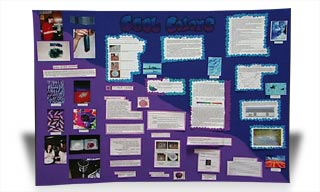 This group of high school chemistry students studied the history of pigments and dyes, the chemical basis for color, and how artists use color in their paintings. In class, they synthesized indigo pigment and then used this pigment to dye fabric samples. Since each sample was made from a different material, students designed tests to see how their absorbency affected the final color of the fabric. Divided into groups, students researched a particular color’s chemical composition and how it was used by artists. At the end of their study, students took a tour of The Art Institute of Chicago and used what they learned in class to interpret the art they observed. After completing their project, one student remarked that “all the times we’ve had discussions before, it was always like science and art are supposed to be opposite ends of the spectrum. This class makes you see how much chemistry is incorporated into art!” This group of high school chemistry students studied the history of pigments and dyes, the chemical basis for color, and how artists use color in their paintings. In class, they synthesized indigo pigment and then used this pigment to dye fabric samples. Since each sample was made from a different material, students designed tests to see how their absorbency affected the final color of the fabric. Divided into groups, students researched a particular color’s chemical composition and how it was used by artists. At the end of their study, students took a tour of The Art Institute of Chicago and used what they learned in class to interpret the art they observed. After completing their project, one student remarked that “all the times we’ve had discussions before, it was always like science and art are supposed to be opposite ends of the spectrum. This class makes you see how much chemistry is incorporated into art!” |
Suggested Curriculum Connections
1. serial dilutions and molarity
2. oxidation and reduction
3. light absorption and wavelength |
| |
9. The Effect of Acid Precipitation on Statues and Buildings
School: Flower Career Academy
Class: 11th grade Environmental Science
Teacher: Deborah W. Brooks-Crutcher
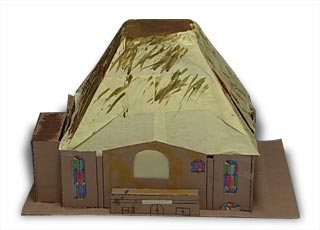 Students in this environmental science class studied the effect of acid rain and other types of air precipitation on buildings and sculptures. They simulated acid rain’s effect by observing and comparing chalk’s interaction with water to its interaction with vinegar, also called acetic acid. Students then considered the effects of acid rain and other pollutants on one of Chicago’s famous landmarks, the Gold Dome building in Garfield Park. They took photographs of the gold domed building and summarized the effect of acid rain on its physical structure. In order to illustrate clearly the condition of the building, students created a model. One student remarked that “as long as we have fossil fuels, we’ll have [acid precipitation] and as long as we have cars, we’re going to have fossil fuels.” Students in this environmental science class studied the effect of acid rain and other types of air precipitation on buildings and sculptures. They simulated acid rain’s effect by observing and comparing chalk’s interaction with water to its interaction with vinegar, also called acetic acid. Students then considered the effects of acid rain and other pollutants on one of Chicago’s famous landmarks, the Gold Dome building in Garfield Park. They took photographs of the gold domed building and summarized the effect of acid rain on its physical structure. In order to illustrate clearly the condition of the building, students created a model. One student remarked that “as long as we have fossil fuels, we’ll have [acid precipitation] and as long as we have cars, we’re going to have fossil fuels.” |
Suggested Curriculum Connections
1. acid rain
2. pH, acids and bases
3. observation and inference
|
| |